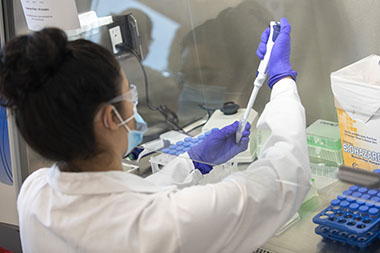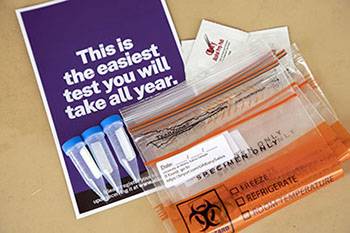COVID-19 Pooled Surveillance Testing Is Underway
 |
|
An RNA Institute team member analyzes saliva samples from the University's pooled surveillance testing program. Photo by Patrick Dodson.
|
ALBANY, N.Y. (Sept. 10, 2020) – The University’s pooled surveillance testing program is well underway and in addition to helping keep our community healthy and safe, the science behind it – happening in a lab right on our Uptown Campus – is receiving national media attention.
Developed by the RNA Institute and the School of Public Health, the program provides a simple and non-invasive way to test the presence of the virus using a saliva sample. Tomoko Udo, associate professor in the School of Public Health, explains that some people infected with the virus have mild or even no symptoms at all (asymptomatic) – but can infect others unknowingly. The pooled surveillance testing on campus is specifically designed to detect the virus in these asymptomatic individuals, so that they can be isolated away from others who could potentially contract the virus and become very ill.
“Normally we think of testing for an infection as something to do when you’re feeling sick so you can get the care you need,” said Eli Rosenberg, an associate professor in the School of Public Health who, along with Udo, is working with the RNA Institute on the program. “That’s diagnostic testing, which is mainly protecting your health. Pooled surveillance testing is different because it is designed to find the seemingly healthy people who have and can spread the virus, which protects the health of others.”
 |
|
The pooled surveillance test kit includes test tubes to collect your saliva sample, alcohol prep pads and biohazard bags. Photo by Patrick Dodson. |
The process is straightforward: Participants, which at UAlbany include all students who spend time on campus and many faculty and staff, spit into provided test tubes on an assigned date and drop the samples off at designated contactless stations. The scientists, led by RNA Institute Director Andrew Berglund, then group four samples together and add a chemical reagent that, once heated, can detect RNA signs of the virus. When a pool tests positive, all four individuals in the pool are asked to isolate and receive official diagnostic testing, at which point the positive individual is identified and confirmed.
A key reason four tests are grouped together in a pooled method is because it allows many more people to be monitored without the expense of individual diagnostic testing for every person. Berglund recently spoke to U.S. News & World Report about the technique, explaining that his team was inspired to build the method optimal for the RNA Institute’s lab after reading about a similar method from Yale University and the University of Illinois at Urbana-Champaign.
The program is a true interdisciplinary partnership, with the RNA Institute working on the science aspect and the School of Public Health helping to oversee the overall program – for example, designing the test kits, enrolling participants, interpreting the data and putting it in a larger public health context that will help advise University administration on next steps.
Rosenberg and Udo explain the importance of such programs for public health, saying, “Surveillance testing programs allow us to get ahead of new outbreaks in our community, compared to relying on only finding symptomatic infections through diagnostic testing. Just like a vaccine, the larger the share of the community who participates, the better this strategy will work.”
To thank students for participating, the RNA Institute is randomly drawing one student’s name from the pooled testing submissions each week to win a $500 non-tuition grant from the University. “The University appreciates students’ willingness to help keep their fellow classmates and community safe, so my team is glad to select students to win grants as a token of the University’s appreciation,” said Berglund.
Residential Life staff distributed kits to all on-campus students, and off-campus students or faculty/staff can get their kits at one of three contactless pickup locations. For more information about the program, visit the website.
![]() For more news, subscribe to UAlbany's RSS headline feeds
For more news, subscribe to UAlbany's RSS headline feeds
About the University at Albany
A comprehensive public research university, the University at Albany-SUNY offers more than 120 undergraduate majors and minors and 125 master's, doctoral, and graduate certificate programs. UAlbany is a leader among all New York State colleges and universities in such diverse fields as atmospheric and environmental sciences, business, public health, health sciences, criminal justice, emergency preparedness, engineering and applied sciences, informatics, public administration, social welfare, and sociology taught by an extensive roster of faculty experts. It also offers expanded academic and research opportunities for students through an affiliation with Albany Law School. With a curriculum enhanced by 600 study-abroad opportunities, UAlbany launches great careers.


